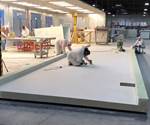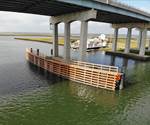FRP piling system used to update Virginia-based ferry terminal
A total of 296 wooden pilings were reportedly replaced by FRP monopile dolphins at one-third the lifecycle cost of wood.
Composite Advantage LLC (Dayton, Ohio, U.S.) has announced that the Virginia Department of Transportation (VDOT, Richmond, Va., U.S.) has invested in its fiber reinforced polymer FiberPILE system for the Jamestown-Scotland Ferry Terminal facility. The agency cited greater cost efficiencies due to FRP’s longer life cycle, reduced service interruptions and safer operation. In 2018 VDOT replaced 8 piles comprised of 37 timbers each with large-diameter FRP monopile dolphins. A total of 296 wooden pilings were reportedly replaced by FRP at one-third the lifecycle cost of wood.
According to Composite Advantage, FiberPILE products are fabricated to high strength-to-weight ratios capable of handling overall ferry crushing loads and adverse wind conditions.
“We fabricated the 100-foot-long FRP monopiles with multiaxial E-glass reinforcement,” explains Composite Advantage President Scott Reeve. “59 percent of the glass fibers used in the lower 80 percent of the pile were orientated at 0 degrees [parallel to the longitudinal axis of the pile]. Eight percent of the glass fibers were given a 90-degree orientation with the remaining fibers oriented at ±45 degrees. Glass fibers for the top 15 feet of the pile [focused on the hoop direction] were manufactured with eight percent at an orientation of 0-degree, [parallel to the longitudinal axis of the pile], 59 percent at an orientation of 90 degrees and the rest of the fibers were given an orientation of ±45 degrees. Wood has a 42 ft-kip energy absorption. This combination gives our monopiles an energy absorption of 585 ft-kip energy absorption.”
FiberPILE also boasts hollow construction, light weight and low driving friction. Following setup which took a day, contractors were reportedly able to drive a 100-foot monopile 25 feet into the river bottom in approximately 20 minutes with minimal disruption.
Related Content
-
Large-format 3D printing enables toolless, rapid production for AUVs
Dive Technologies started by 3D printing prototypes of its composite autonomous underwater vehicles, but AM became the solution for customizable, toolless production.
-
Plant tour: BeSpline/Addcomp, Sherbrooke, QC, Canada
Composites automation specialist increases access to next-gen technologies, including novel AFP systems and unique 3D parts using adaptive molds.
-
MerConcept, Extracthive integrate rCF components into racing yacht construction
Development and integration of recycled composite ballast dorade vents for an IMOCA class yacht and other ongoing projects demonstrate a push for greater circularity in the marine industry.















